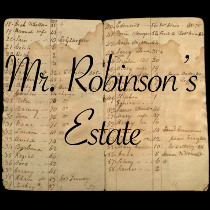Mr. Robinson’s Estate
 When Mr. Robinson, a wealthy Virginia planter, died in 1826, the law required that his estate be assessed and appraised before it could be passed on his heirs. In addition to listing all his material possessions, the assessors listed his human chattel property, as well–the 76 men, women, and children he had enslaved. Moreover, they made notes from a previous ledger to identify any changes that had affected the enslaved individuals in recent years, such as childbirth, death, or injury. While the assessors undertook this task for financial and legal purposes, they unintentionally left us a rich archive that identifies trends in family life, the community of the enslaved, and plantation relationships. Ultimately, these documents serve a two-fold purpose, they both list the enslaved as whites saw them–namely, property to be grouped, appraised, and distributed–while also hinting at what aspects of family life and culture were and were not possible for the enslaved.
When Mr. Robinson, a wealthy Virginia planter, died in 1826, the law required that his estate be assessed and appraised before it could be passed on his heirs. In addition to listing all his material possessions, the assessors listed his human chattel property, as well–the 76 men, women, and children he had enslaved. Moreover, they made notes from a previous ledger to identify any changes that had affected the enslaved individuals in recent years, such as childbirth, death, or injury. While the assessors undertook this task for financial and legal purposes, they unintentionally left us a rich archive that identifies trends in family life, the community of the enslaved, and plantation relationships. Ultimately, these documents serve a two-fold purpose, they both list the enslaved as whites saw them–namely, property to be grouped, appraised, and distributed–while also hinting at what aspects of family life and culture were and were not possible for the enslaved.
As you read these documents, please consider the following:
-
What can we understand from the family structures as they are listed? What is important about the ages and number of children in these families?
-
How does the annotation reveal the white mind towards the enslaved? What did they deem appropriate to make note of, and what did they omit?

